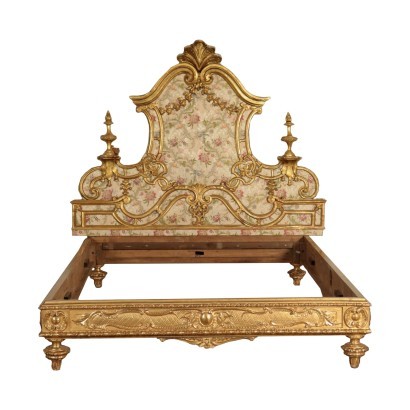Eclectic Neo-Baroque Big Bed Italy 19th Century
Features
Style: Neo-Baroque (1860-1890)
Age: 19th Century / 1801 - 1900
Origin: Italy
Description
Supporte by 4 top shaped feet, richly engraved and opaque gold leaf gilded sides and footboard. Headboard made of a central cymatium decorated with a shell on the upper part between two lateral scrolls on which there is a pair of torch-holders angraved all around. The central part is paddend and decorated with scrolls and glided engrave curls.
Product Condition:
Fair condition. Wear consistent with age and use.
Dimensions (cm):
Height: 183
Width: 153,5
Depth: 217
Bed frame maximum sizes (cm):
Width: 170
Depth: 230
Certificate issued by: Enrico Sala, expert
Additional Information
Style: Neo-Baroque (1860-1890)
Anticipated in England in the first half of the 19th century on reminiscences of the Elizabethan style, it returns in vogue around 1870, but interpreted in a very free way.At the beginning it represents a response to the frivolity of the neo-rococo, but soon expires in a pompous and eclectic style that combines severe sixteenth-century elements with early seventeenth-century sculptural decorations.
The furniture is solid, richly carved and carved, in wood with a dark patina.
Masks, cornices, columns carved with herms that make up typical architectural structures of Renaissance palaces, are the elements that characterize the neo-Renaissance style.
It was an era in which we saw the revival and the revival of ancient forms with a typically Renaissance taste, large carvings were used for an all-round, deeper and three-dimensional vision, the use of feral legs in the caissons and in the wardrobes, squares and moldings, frames, ashlar and nails, Romanesque ornamental motifs but also acanthus leaves, cartouches and lion heads.
Often in this period the furniture is built using ancient materials and parts of Renaissance furniture.
Walnut was often used but also less hard essences such as poplar or others since they were often darkened and presented in black.
Find out more with the insights of our blog:
The Neobarocco in a large table of '800






















